Related Research Articles

Chenin blanc is a white wine grape variety from the Loire Valley of France. Its high acidity means it can be used to make varieties from sparkling wines to well-balanced dessert wines, although it can produce very bland, neutral wines if the vine's natural vigor is not controlled. Outside the Loire, it is found in most of the New World wine regions; it is the most widely planted variety in South Africa, where it was historically also known as Steen. The grape may have been one of the first to be grown in South Africa by Jan van Riebeeck in 1655, or it may have come to that country with Huguenots fleeing France after the revocation of the Edict of Nantes in 1685. Chenin blanc was often misidentified in Australia, as well, so tracing its early history in the country is not easy. It may have been introduced in James Busby's collection of 1832, but C. Waterhouse was growing Steen at Highercombe in Houghton, South Australia, by 1862.

The Muscat family of grapes includes over 200 grape varieties belonging to the Vitis vinifera species that have been used in wine production and as raisin and table grapes around the globe for many centuries. Their colors range from white, to yellow, to pink to near black. Muscat grapes and wines almost always have a pronounced floral aroma. The breadth and number of varieties of Muscat suggest that it is perhaps the oldest domesticated grape variety, and there are theories that most families within the Vitis vinifera grape variety are descended from the Muscat variety.

Baco blanc or Baco 22A is a French-American hybrid grape variety. It is a cross of Folle blanche and the Noah grape, created in 1898 by the grape breeder François Baco. Folle blanche is its Vitis vinifera parent. Noah, its other parent, is itself a cross of Vitis labrusca and Vitis riparia.

Aligoté is a white grape used to make dry white wines, especially in the Burgundy region of France where it was first recorded in the 18th century. Since it is tolerant to cold, this variety is also cultivated in Eastern European countries. In 2004, it was the 22nd most planted vine variety in the world at 45,000 hectares.

Trebbiano is an Italian wine grape, one of the most widely planted grape varieties in the world. It gives good yields, but tends to yield undistinguished wine. It can be fresh and fruity, but does not keep long. Also known as ugni blanc, it has many other names reflecting a family of local subtypes, particularly in Italy and France. Its high acidity makes it important in Cognac and Armagnac productions.
Arbois or Arbois Blanc is a white French wine grape variety planted primarily in the Loire regions. Despite being a minor grape, in the late 20th century it was the third most widely planted grape variety in the Loir-et-Cher département which includes the winemaking areas of Cheverny, Cour-Cheverny, Montrichard, Oisly, Saint-Romain-sur-Cher, Valençay as well as vineyards that make wines under the Touraine AOC, Cremant de Loire AOC and Vin de Pays du Loir et Cher. By 2004 acreage had steadily declined to around 750 acres. It is still a permitted grape variety in the Appellation d'origine contrôlée (AOC) regions of Cheverny AOC, Valençay AOC and Vouvray AOC.

Gouais blanc or Weißer Heunisch is a white grape variety that is seldom grown today but is important as the ancestor of many traditional French and German grape varieties. The name Gouais derives from the old French adjective ‘gou’, a term of derision befitting its traditional status as the grape of the peasants. Likewise, the German name Weißer Heunisch labels it as one of the lesser "Hunnic" grapes.

French wine is produced all throughout France, in quantities between 50 and 60 million hectolitres per year, or 7–8 billion bottles. France is one of the largest wine producers in the world, along with Italian, Spanish, and American wine-producing regions. French wine traces its history to the 6th century BCE, with many of France's regions dating their wine-making history to Roman times. The wines produced range from expensive wines sold internationally to modest wines usually only seen within France such as the Margnat wines of the post war period.

Languedoc-Roussillon wine, including the vin de pays labeled Vin de Pays d'Oc, is produced in southern France. While "Languedoc" can refer to a specific historic region of France and Northern Catalonia, usage since the 20th century has primarily referred to the northern part of the Languedoc-Roussillon région of France, an area which spans the Mediterranean coastline from the French border with Spain to the region of Provence. The area has around 700,000 acres (2,800 km2) under vines and is the single biggest wine-producing region in the world, being responsible for more than a third of France's total wine production. In 2001, the region produced more wine than the United States.
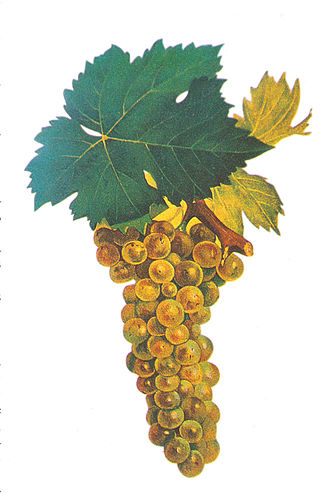
Muscat Blanc à Petits Grains is a white wine grape of Greek origin that is a member of the Muscat family of Vitis vinifera. Its name comes from its characteristic small berry size and tight clusters. It is known under a variety of local names such as Moscato bianco, Muscat blanc, Muscat Canelli, Muscat de Frontignan, Muscat de Lunel, Muscat d'Alsace, Muskateller, Moscatel de Grano Menudo, Moscatel rosé and Sárgamuskotály.
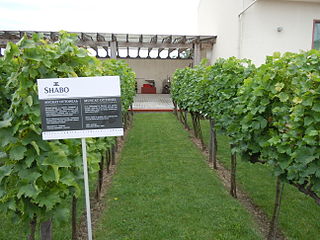
Muscat Ottonel or Muskat-Ottonel is a white wine grape variety that is a member of the Muscat family of Vitis vinifera. It is most notable for its use in dessert wines from Austria, Bulgaria, Romania, Moldova, Croatia and Serbia as well as dry wines from Alsace and Hungary. In Alsace, the varietal designation Muscat d'Alsace is allowed for the varieties Muscat Ottonel, Muscat blanc à petit grains and Muscat rose à petit grains blended in any combination -or not-, and blends between these are not allowed for most Alsace Grands Crus.

Piquepoul, Picpoul, or Picapoll is a variety of wine grape grown primarily in the Rhone Valley and Languedoc regions of France as well as Catalonia, Spain. It exists both in dark-skinned and light-skinned versions, as well as a very little grown Piquepoul gris. Piquepoul blanc is the most common of the Piquepouls, with 1,000 hectares cultivated in France in 2000, and an increasing trend.

Aramon or Aramon noir is a variety of red wine grape grown primarily in Languedoc-Roussillon in southern France. Between the late 19th century and the 1960s, it was France's most grown grape variety, but plantings of Aramon have been in continuous decline since the mid-20th century. Aramon has also been grown in Algeria, Argentina and Chile but nowhere else did it ever reach the popularity it used to have in the south of France.
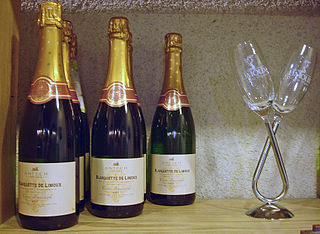
Limoux wine is produced around the city of Limoux in Languedoc in southwestern France. Limoux wine is produced under four Appellation d'origine contrôlée (AOC) designations: Blanquette de Limoux, Blanquette méthode ancestrale, Crémant de Limoux and Limoux, the first three of which are sparkling wines and dominate the production around Limoux. The main grape of the region is the Mauzac, locally known as Blanquette, followed by Chardonnay and Chenin blanc. In 2005, the Limoux AOC was created to include red wine production consisting of mostly Merlot. Wine historians believe that the world's first sparkling wine was produced in this region in 1531, by the monks at the abbey in Saint-Hilaire.
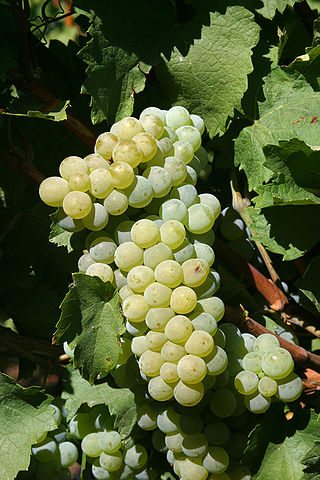
Elbling is a variety of white grape which today is primarily grown in the upstream parts of the Mosel region in Germany and in Luxembourg, where the river is called Moselle. The variety has a long history, and used to cover much of Germany's vineyards from medieval times and was that country's most cultivated variety until the early 20th century, but has been in decline ever since. As of 2006, there were 583 hectares of Elbling vineyards in Germany, which made it the country's 23rd most grown variety of grape. Of that vineyard surface, 575 ha or 98.6% was found in the Mosel region In the same year, there were 122.9 hectares of Elbling grown in Luxembourg.

Provence (Provençal) wine comes from the French wine-producing region of Provence in southeast France. The Romans called the area provincia nostra, giving the region its name. Just south of the Alps, it was the first Roman province outside Italy.

Corsica wine is wine made on the Mediterranean island of Corsica. Located 90 km west of Italy, 170 km southeast of France and 11 km north of the island of Sardinia, the island is a territorial collectivity of France, but many of the region's winemaking traditions and its grape varieties are Italian in origin. The region's viticultural history can be traced to the island's settlement by Phoceans traders in 570 BC in what is now the commune of Aléria. In the 18th century, the island came under the control of France. Following the independence of Algeria from French rule, many Algerian Pieds-Noirs immigrated to Corsica and began planting vineyards. Between 1960 and 1976 the vineyard area in Corsica increased fourfold. In 1968, Patrimonio was established as Corsica's first Appellation d'origine contrôlée (AOC). Today, Corsica has nine AOC regions including the island-wide designation Vin de Corse AOC. The majority of the wine exported from Corsica falls under the Vin de pays designation Vin de Pays de l'Île de Beauté. The three leading grape varieties of the region are Nielluccio (Sangiovese), known as the spice wine of France, Sciacarello and Vermentino.
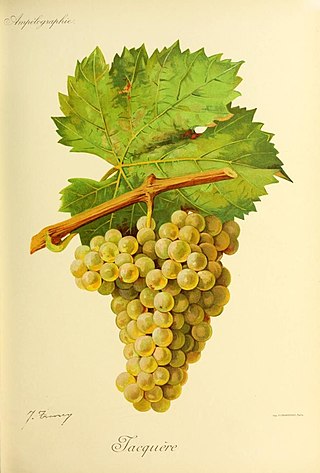
Jacquère is a variety of white grape found primarily in the Savoy wine region of France. It is a high-yielding vine variety which is used to produce lightly scented, refreshing and gently aromatic dry white wine, such as Vin de Savoie. Jacquère is the grape used in Apremont wines and is the usual wine paired with cheese fondue. It is also found in Bugey wines.
Graisse is a white French wine grape variety that is grown primarily in the Armagnac region of western France where the grape is used for both wine production and distillation. The pulp of the grape is characterized by its high viscosity levels, which can create some difficulties in winemaking, to produce a wine that expert Jancis Robinson describes as being of average to low quality. In recent years, plantings of Graisse have been steadily declining.
Baroque is a white French wine grape planted primarily in South West France around the Tursan region. It can make full bodied wines with nutty flavors. Ampelographers suspect that the grape maybe a crossing of Folle Blanche and Sauvignon blanc.
References
- 1 2 Monbadon Archived 2012-04-30 at the Wayback Machine , Vitis International Variety Catalogue, accessed 2010-07-14
- ↑ J. Robinson Jancis Robinson's Wine Course Third Edition pg 101 Abbeville Press 2003 ISBN 0-7892-0883-0